
 


 | |
|
Spain & Portugal 2002
In april & may of 2002, Eric and I drove down to Portugal
and Spain for a two-week vacation. We spent the first week
at the beach near Monte Gordo,
in the Portuguese Algarve,
at just a few kilometers from
the Spanish Border. In the second week, we visited
Granada (with the famous Alhambra
palace) and Barcelona, in Spain. You can find some practical info on this trip in
general on this trip's home page.
Other links for this trip: 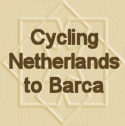 Eric and I returned to Barcelona in 2003, but this time
coming by bike from the Netherlands. See my pages on this
cycling trip
Eric and I returned to Barcelona in 2003, but this time
coming by bike from the Netherlands. See my pages on this
cycling trip
Barcelona, Spain Barcelona is a great city to visit: there's plenty to see and do, and it's very easy to find you way around as a tourist. Practical info: we got there by car, but travelled around the city on foot, mostly. We stayed at Hotel Marvi, which was good, with very friendly staff, and not too expensive. It's within easy walking distance of the Ramblas, the heart of Barcelona. We had booked the hotel via the internet. To get a good impression of Barcelona, there is a "bus turistic": two tourist bus lines that take you all around the city, on a "north loop" and a "south loop." You buy a ticket for an entire day, and you can get on or off wherever you like, and for as long as you like. You can buy the ticket on the bus, it's about 14 euro for one day, and 17 euro for two days. The best place to start the bus trips is at the Pl. de Catalunya. To me, the highlight of Barcelona - by far - was the Sagrada Familia. This is a cathedral, which is at this moment still under construction; construction was started in 1882. If there's just one thing for which you want to tear yourself away from the tapas and sangria, let this be it! It's a unique opportunity to be able to visit a cathedral that is under construction, and this is not just any cathedral either! It's fantastically original, completely unlike anything I've seen before, which is not surprising considering the architect: Antoni Gaudi (1852-1926). For example, the tops of the towers are colorful, there are carvings of fruit and a cypress tree, and there's a mathematical "magic square." 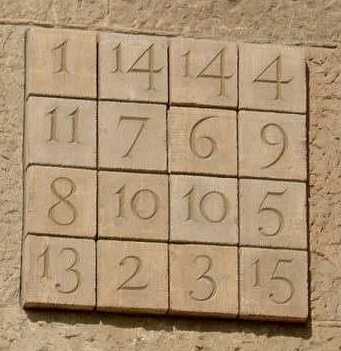
In the magic square, shown above, the numbers add up to 33 (Jesus' supposed age) in every direction. The four middle numbers (7, 6, 10, 10) also add up to 33, and this is the case for a few more blocks of four numbers. 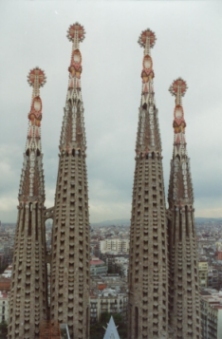
Gaudi took over from the original architect in 1883, and dedicated nearly all of his time to this project. In his later years, he even lived on-site in the beginnings of the cathedral, so that he could devote himself to it completely. So far, construction of the temple has been held back by several strokes of "bad luck," such as Gaudi's death in 1926 (he was run over by a streetcar), destruction of all of Gaudi's drawings and maquettes in a fire in 1936 (Spanish civil war), and financial problems. More recently, however, construction has been simplified through the invention of cranes and concrete. 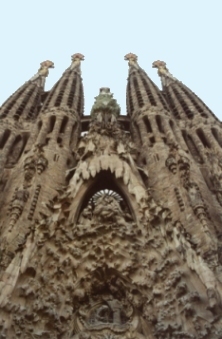
When finished, the Sagrada Familia is going to be an impressive building, with eighteen towers, the tallest of which is planned to be 170 meters high. Two of the planned four facades are finished at this time; the Nativity facade was finished in 1933, and is shown in the photograph above. The Passion facade is shown below. Note that this facade is much lighter in color than the Nativity facade, due to its more recent construction. Also, there is a clear difference between the styles of the two facades; the older Nativity facade has many "organic" details, whereas the Passion facade is far more modern. 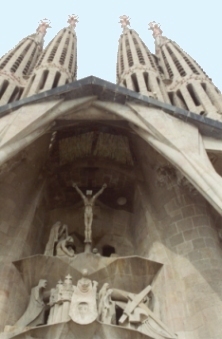
Part of the Sagrada Familia is open to visitors. You have to pay a "donation," which is used to finance further construction. We had to wait in line for close to 45 minutes. Once you're in, though, it's something to see. Right now, the naves and the transept are being constructed. The photograph below shows some of the columns being built in one of the naves. The side walls have not yet been built, so that you're half inside and half outside. Note the tree-like structure of the columns, with "leaves" at the top. 
Something you mustn't miss when visiting the Sagrada Familia is a climb up the towers at the Nativity end. There's a great view of Barcelona, but you also get to see some of the carvings of the Nativity facade up close, as the towers have many windows. There are also little turrets where you can step outside of the towers at considerable height, and bridges which take you from one tower to the next - these are scary if you're afraid of heights. If you go all the way up, you cross a bridge from which you look right down into the construction of the central areas of the cathedral, as shown below. Actually, seeing the Sagrada Familia as it is now has increased my respect for the builders of all other cathedrals considerably. It's very interesting to see what a huge undertaking this is. 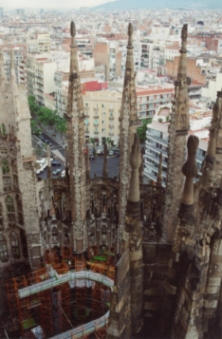
A few other links: 
Apart from the Sagrada Familia, there's plenty more Gaudi stuff in Barcelona, the most famous of which is probably Park Guell (pronounced something like "way"). If you take the tourist bus routes, you'll see plenty of Gaudi's work dotting the city. It's not hard to recognize: look for wavy lines and colored tiling, as in the bench (in Park Guell) in the photograph below. I saw some of Friedensreich Hundertwasser's work in Vienna last year, and was struck by the similarity to Gaudi's work. However, Hundertwasser lived from 1928 to 2000, while Gaudi died in 1926, so Hundertwasser must have been inspired by Gaudi. Imagine what might have come forth if they'd been contemporaries. What else should you do in Barcelona? There's the Picasso Museum, of course, where I particularly liked seeing the studies on Picasso's version of "Las Meninas" (after Diego Velazquez). Some of Picasso's versions of "Las Meninas" are completely abstract, but certain anchor points are always recognizable. This page has some more info on Las Meninas, and you can find the Velazquez original, at reasonable resolution, here. The good thing about Barcelona is, there's also a lot to do apart from the cultural stuff. Take a walk along the harbor, and imagine Columbus sailing in to report his discovery of America to King Ferdinand. Or go shopping (or watch people going shopping) on Las Ramblas. Enjoy the excellent food, or visit the Olympic Village. In any case, there's plenty for everyone. | |
|
Judith's |Home| |Nepal| |Sweden| |Canada| |cycling to Spain| |Australia| I'm comparing two trackers of visitors to this site. |